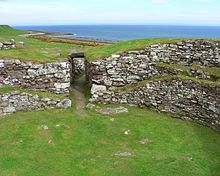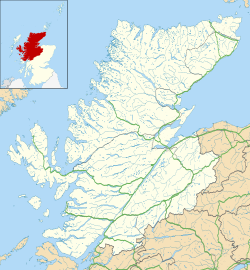57°59′14″N 3°54′43″W / 57.987215°N 3.912052°W
 Interior of Carn Liath | |
| Location | Scottish Highlands |
|---|---|
| Coordinates | 57°59′14″N 3°54′43″W / 57.987215°N 3.912052°W |
| Type | Broch |
| History | |
| Periods | Iron Age |
| Site notes | |
| Ownership | Historic Environment Scotland |
Càrn Liath (English: Grey Cairn) [1] is an Iron Age broch on the eastern shore of the Scottish Highlands, near Golspie, Sutherland.
Location
The broch is located near Golspie in Sutherland. [2] It stands beside the A9 road, around 4 kilometres northeast of Golspie. [3] The site is under the care of Historic Environment Scotland and has a car-park and information board for visitors. [1]
Description
The broch has an external diameter of around 19 metres and an internal diameter of around 10 metres. [2] The broch wall is particularly thick. [1] The entrance passage is on the east side and is over 4 metres long. [2] The entrance has elaborate door checks and a bar-hole to control access to the interior. [4] On the right-hand side of the entrance passage is a small guard cell. [1]
The surrounding enclosure contains the ruins of additional stone buildings. [1]
Excavations
The broch was first excavated in the 19th century by the Duke of Sutherland, and was initially thought to be a burial cairn. [5] Finds included pottery, flint chips, stone hammers, mortars and pestles, querns, whorls, shale rings, long-handled bone combs, a whale bone club, a silver fibula, steatite cups and an iron blade. [5]
In 1909 the entrance passage was still visible on the east side of the broch, but by 1960 no structural features were discernible. [2]
The site was excavated again in 1986. [5] This showed that the site was occupied in the Bronze Age, before the broch was built. [5] A Bronze Age cist burial with a food vessel was discovered. [5] The foundations of many outbuildings were found in the enclosure surrounding the broch. [4] Although many were clearly from a later period, some may have been contemporary with the broch. [4]
Notes
- ^ a b c d e "Carn Liath". Historic Environment Scotland. Retrieved 4 January 2021.
- ^ a b c d Historic Environment Scotland. "Carn Liath (6833)". Canmore. Retrieved 16 September 2014.
- ^ Ritchie, J N G (1998). Brochs of Scotland. Shire Publications. p. 45. ISBN 0747803897.
- ^ a b c Armit, Ian (1998). Scotland's Hidden History. Tempus. p. 105. ISBN 0752414003.
- ^ a b c d e MacSween, Ann; Sharp, Mick (1989). Prehistoric Scotland. New Amsterdam. p. 57. ISBN 071346173X.
Further reading
- P. Love (1989) Recent excavations at Carn Liath Broch, Golspie, Sutherland. GAJ, 15, 1988-9: 157-69
External links
- Carn Liath at Historic Environment Scotland.
57°59′14″N 3°54′43″W / 57.987215°N 3.912052°W
 Interior of Carn Liath | |
| Location | Scottish Highlands |
|---|---|
| Coordinates | 57°59′14″N 3°54′43″W / 57.987215°N 3.912052°W |
| Type | Broch |
| History | |
| Periods | Iron Age |
| Site notes | |
| Ownership | Historic Environment Scotland |
Càrn Liath (English: Grey Cairn) [1] is an Iron Age broch on the eastern shore of the Scottish Highlands, near Golspie, Sutherland.
Location
The broch is located near Golspie in Sutherland. [2] It stands beside the A9 road, around 4 kilometres northeast of Golspie. [3] The site is under the care of Historic Environment Scotland and has a car-park and information board for visitors. [1]
Description
The broch has an external diameter of around 19 metres and an internal diameter of around 10 metres. [2] The broch wall is particularly thick. [1] The entrance passage is on the east side and is over 4 metres long. [2] The entrance has elaborate door checks and a bar-hole to control access to the interior. [4] On the right-hand side of the entrance passage is a small guard cell. [1]
The surrounding enclosure contains the ruins of additional stone buildings. [1]
Excavations
The broch was first excavated in the 19th century by the Duke of Sutherland, and was initially thought to be a burial cairn. [5] Finds included pottery, flint chips, stone hammers, mortars and pestles, querns, whorls, shale rings, long-handled bone combs, a whale bone club, a silver fibula, steatite cups and an iron blade. [5]
In 1909 the entrance passage was still visible on the east side of the broch, but by 1960 no structural features were discernible. [2]
The site was excavated again in 1986. [5] This showed that the site was occupied in the Bronze Age, before the broch was built. [5] A Bronze Age cist burial with a food vessel was discovered. [5] The foundations of many outbuildings were found in the enclosure surrounding the broch. [4] Although many were clearly from a later period, some may have been contemporary with the broch. [4]
Notes
- ^ a b c d e "Carn Liath". Historic Environment Scotland. Retrieved 4 January 2021.
- ^ a b c d Historic Environment Scotland. "Carn Liath (6833)". Canmore. Retrieved 16 September 2014.
- ^ Ritchie, J N G (1998). Brochs of Scotland. Shire Publications. p. 45. ISBN 0747803897.
- ^ a b c Armit, Ian (1998). Scotland's Hidden History. Tempus. p. 105. ISBN 0752414003.
- ^ a b c d e MacSween, Ann; Sharp, Mick (1989). Prehistoric Scotland. New Amsterdam. p. 57. ISBN 071346173X.
Further reading
- P. Love (1989) Recent excavations at Carn Liath Broch, Golspie, Sutherland. GAJ, 15, 1988-9: 157-69
External links
- Carn Liath at Historic Environment Scotland.
